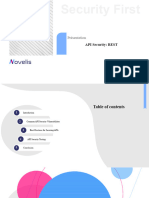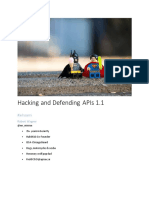0% found this document useful (0 votes)
14 views2 pagesAPI Security Essentials - Academic Structured
This document provides an overview of API security, highlighting common vulnerabilities, best practices for authentication and authorization, and secure design principles. It also discusses tools for testing APIs and includes a case study on API key leakage. The conclusion emphasizes the importance of proper design, validation, and monitoring to ensure API security.
Uploaded by
nivedtest1604Copyright
© © All Rights Reserved
We take content rights seriously. If you suspect this is your content, claim it here.
Available Formats
Download as PDF, TXT or read online on Scribd
0% found this document useful (0 votes)
14 views2 pagesAPI Security Essentials - Academic Structured
This document provides an overview of API security, highlighting common vulnerabilities, best practices for authentication and authorization, and secure design principles. It also discusses tools for testing APIs and includes a case study on API key leakage. The conclusion emphasizes the importance of proper design, validation, and monitoring to ensure API security.
Uploaded by
nivedtest1604Copyright
© © All Rights Reserved
We take content rights seriously. If you suspect this is your content, claim it here.
Available Formats
Download as PDF, TXT or read online on Scribd
/ 2
































































